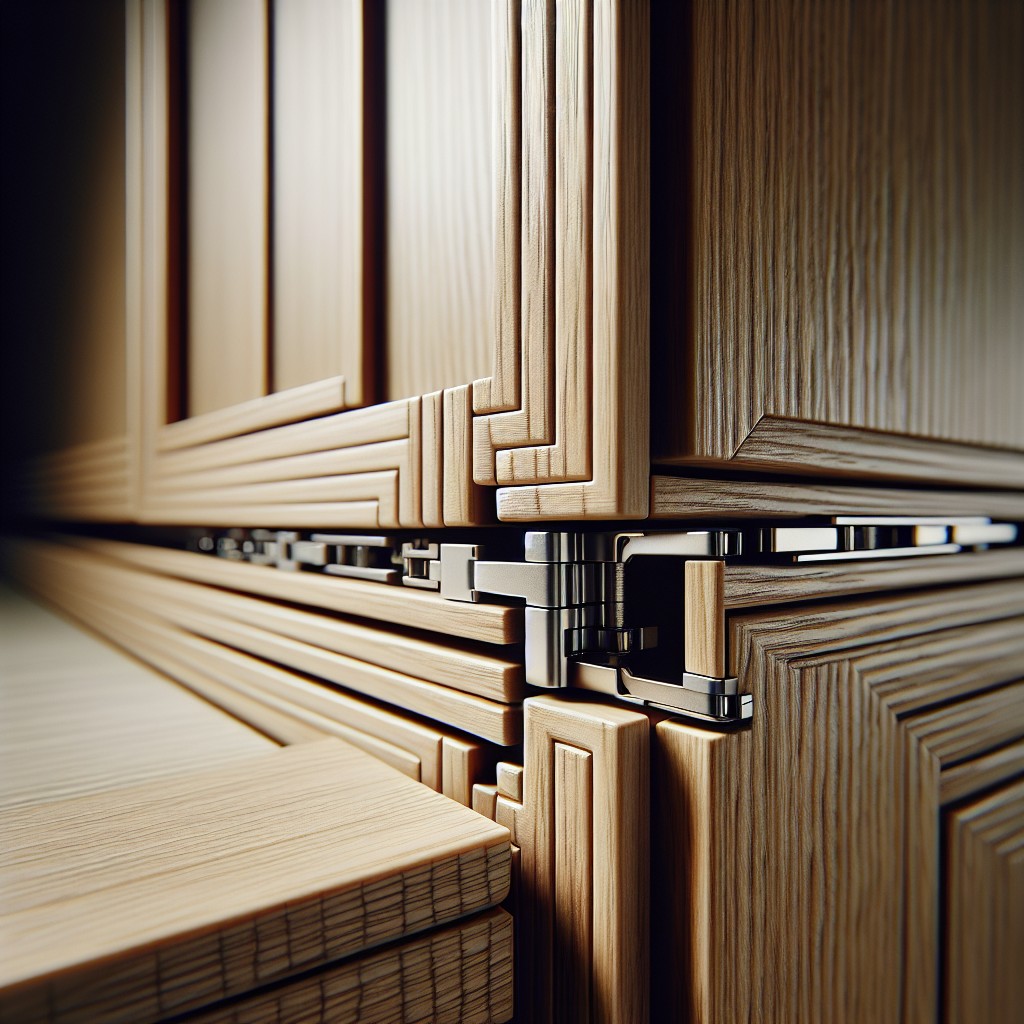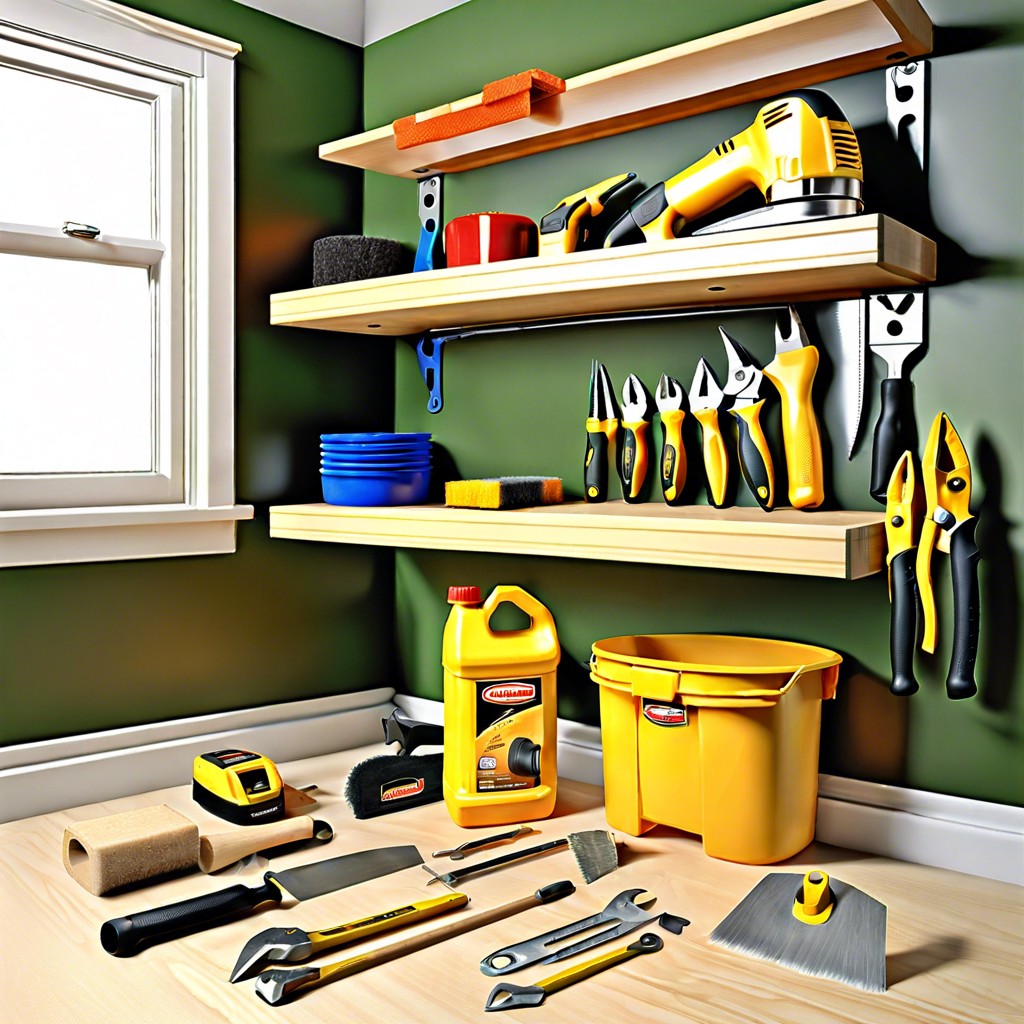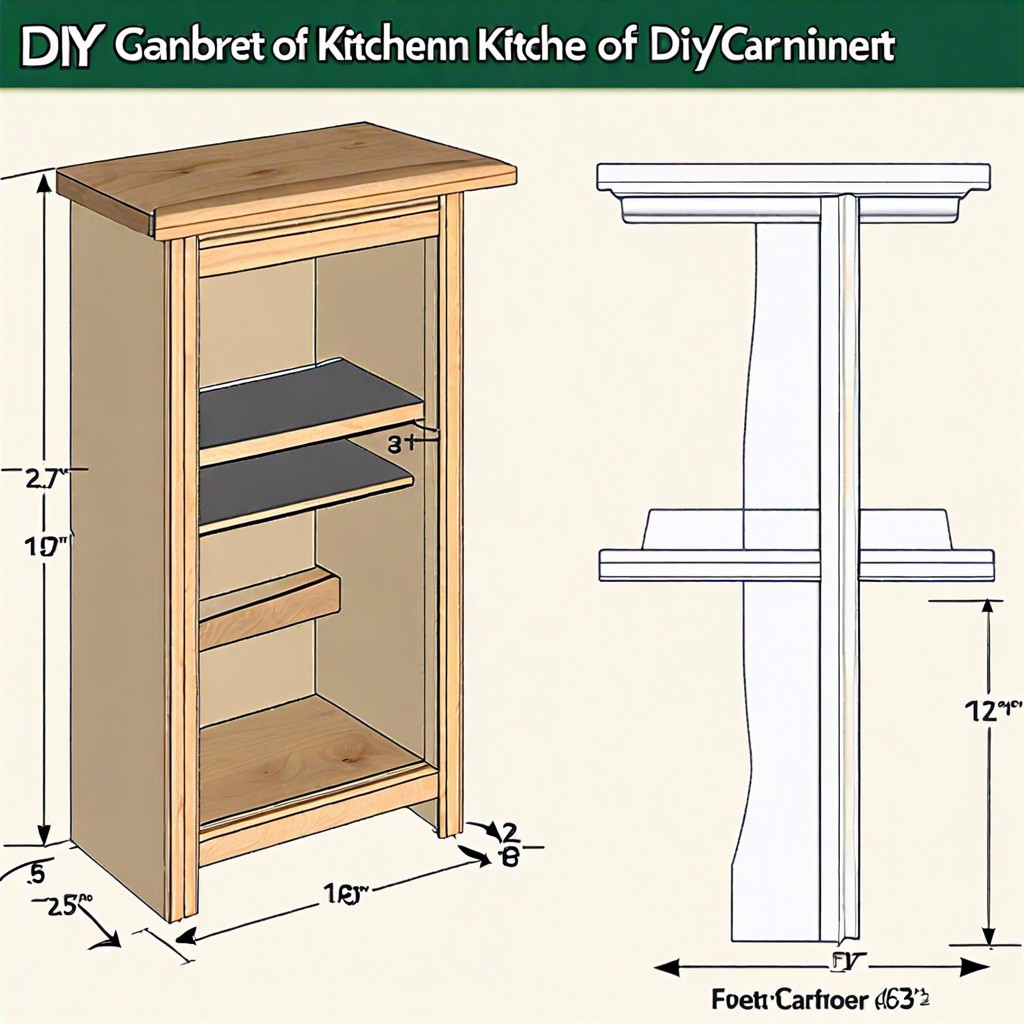Last updated on
Transforming your kitchen or bathroom cabinets with soft close hinges is essential because it enhances functionality, longevity, and gives a high-end feel.
Swapping out those old cabinet hinges for a smoother, quieter soft close model is a DIY project that can dramatically change your kitchen’s ambiance. This transformation is not only relatively simple; it also requires only a few tools commonly found in most homes and can be completed in less than an hour.
This article will provide a clear and easy-to-follow guide on how to replace old cabinet hinges with soft close hinges perfectly. Aimed at offering all the details you need, from choosing the best soft close hinges to the most efficient installation techniques, your kitchen cabinets will soon be closing smoothly and silently.
Trust me, you’ll love the difference!
Key takeaways:
- Soft close hinges enhance functionality and longevity of cabinets.
- Identify face frame or frameless cabinet style for hinge requirements.
- Determine door style (standard, full overlay, inset) for proper hinge selection.
- Choose between compact or long arm soft close hinges based on cabinet design.
- Evaluate the condition of existing cabinets before adding soft close hinges.
What's Inside
Understanding How Soft Close Hinges Work

Soft close hinges are a popular choice for cabinets due to their ability to close doors and drawers gently, preventing slamming and reducing noise in the home. A hydraulic mechanism within the hinge slows down the closing motion of the door, guiding it to a smooth and quiet closure.
It’s interesting to note that even when closed with a force, the hinges have a damper that absorbs the shock, converting it into energy to assist in the closing process. This damper is adjustable, allowing you to control the speed of the soft close mechanism based on your preference.
Another important aspect of soft close hinges is their durability. Designed using robust materials and technology, they are built to withstand heavy usage over a long period, serving as a long-term investment option for your cabinet enhancements.
Identifying Cabinet Style: Face Frame or Frameless

Incorporating soft close hinges requires recognizing if you’re working with a face frame or frameless cabinet style.
Face frame cabinets, a staple in American homes, showcase a supportive frame attached to the cabinet box’s front. The cabinet doors are subsequently hinged to this frame.
On the other hand, frameless cabinets, often termed European style, lack this front frame. Instead, doors attach directly to the cabinet box.
Distinguishing between these two styles is vital as hinge requirement differs. This fact also affects the mounting plate type needed for your cabinet. For face frame cabinets, you’ll typically be looking at compact style hinges. Conversely, frameless cabinets usually go well with long arm hinges.
Armed with such knowledge, you’ll ensure a smoother transition accommodating the soft close feature into your cabinets.
Determining Cabinet Door Style: Standard, Full Overlay, or Inset
Once you’ve recognized the overall structure of your cabinetry, pay close attention to the door itself. This detail plays a major role in selecting the ideal soft close hinge.
First off, standard (or partial) overlay doors are what you’ll commonly find in older, traditionally styled kitchens. These doors cover a portion of the cabinet face, leaving some visible when the door is closed. Typically, the reveal (visible cabinet face) measures about 1/2 inch.
Full overlay doors, on the other hand, cover almost the entire cabinet face, leaving only about 1/8 inch of it visible. The resulting effect gives a more modern and seamless look – an ideal choice for contemporary kitchens.
Lastly, there are inset doors. These are designed to sit inside the cabinet frame instead of laying on top of it. Here, the cabinet face is entirely visible around the doors when closed.
Identifying these styles is crucial as each requires uniquely sized and placed hinges to ensure proper alignment and function. Remember, the goal is a smooth and silent close.
Choosing Soft Close Hinge Style: Compact or Long Arm
Opting between compact and long arm soft close hinges boils down to cabinetry’s interior space and personal aesthetic preferences.
Compact hinges, often chosen for their unobtrusive design, fit perfectly in tighter spaces. They don’t extend as far into the cabinet, keeping the cabinets’ interior crisp and clean. Moreover, they’re quite discreet, offering a more streamlined look when the cabinet door is open.
Long arm hinges, on the other hand, extend farther into the cabinetry. They offer a larger range of motion, making them an excellent choice for wider cabinets or doors. Generally, they can open up to 170 degrees, offering incredible flexibility, particularly in high-use or tight areas.
Each hinge style has strengths worth considering to ensure perfect alignment with the cabinetry design, size, and functional requirements. Remember, appearance and functionality work hand-in-hand when setting up a desirable kitchen or other areas with cabinets.
Selecting Old Cabinets Suitable for Soft Close Hinges Addition
When considering the integration of soft close features into an existing cabinet, it’s crucial to evaluate the condition of your cabinets. Here are factors to determine the suitability:
- Construction Quality: Sturdily built cabinets with solid materials like hard plastic, metal, or hardwood can endure hinge modifications.
- Hinge Area Overview: Inspect the area on the door where the hinge will fit. If there’s extensive wear or damage, it may be challenging to install a new hinge.
- Door Thickness: Profoundly thin doors may not support the weight of new hinges and may not close properly.
- Cabinet Design: Some intricate, antique, or custom cabinet designs may not work with standard soft close hinges.
- Frame Condition: The condition of the cabinet’s frame is essential. Soft close hinges need a sturdy frame to ensure proper functioning.
Remember, sometimes it can be more cost-effective to replace old, worn-out cabinets instead of retrofitting them with soft close hinges.
Estimating Cost of Adding Soft Close to Cabinets
The cost of soft close hinges typically ranges from $3 to $6 per piece, depending on the type, style, and brand. Before making a purchase, take an inventory of the number of cabinets in your home that you plan to retrofit. Keep in mind that a standard cabinet door usually requires two hinges.
While this is a seemingly high upfront cost, remember that these hinges are a long-term investment enhancing the daily functionality and overall aesthetic of your kitchen. They minimize wear and tear on cabinets, and they suppress the noise of closing doors and drawers.
Additionally, factor in the cost of the necessary tools to complete the hinge replacement. Simple tools such as a drill and a screwdriver could already be in your toolbox. However, you might need to invest in specialized tools like a 35mm Forstner drill bit for drilling the holes for the hinges.
Please note, the cost stated here is an estimation and may differ based on your location and the retailer’s pricing.
Reviewing Necessary Tools and Supplies for Hinge Installation
For the task at hand, a few specific tools will make the job easier and ensure a smooth installation process. The basic tools include a screwdriver, preferably power-operated, to remove and attach hinges. Additionally, it would be beneficial to have both Phillips and flat-head types since different hinges might require different screw heads.
A 35mm Forstner bit is necessary for drilling the hole for the hinge cup. It’s essential to get a Forstner bit as it creates clean, accurate holes. For this task, a cordless drill proves to be quite handy.
A hole-cutter jig for 35mm cup-style hinges can provide precision, especially if numerous doors need hinge replacement. This tool ensures that the hole is of the right depth and the center point is correctly positioned.
Finally, a level and a pencil will be of great assistance for marking the spot where holes need to be drilled and checking to see if the doors are hanging straight. Make sure to use a soft tape measure for accurate measurements while fitting the doors. With these supplies at hand, you’ll be well-equipped to tackle hinge installation successfully.
Removing Old Cabinet Doors and Hinges
Before initiating this process, safeguard your work area and yourself with protective eyewear and gloves.
Start off by opening the cabinet door so that the hinges are visible. A screwdriver will serve as the primary tool to detach the existing hinges. Look for the screws fastening the hinges to the cabinet door, which are typically at the center. Once located, unscrew carefully to avoid causing any wood damage.
Should the hinge contain a cover plate, remove it to expose the screws.
Afterward, focus on the part of the hinge attached to the cabinet frame. Again, use your screwdriver to unscrew it. Keep all screws in a secure place; they’ll be handy in case of missing parts in new hinge packs.
Once both components are unscrewed, the door should be free. Repeat these steps for all the doors you are refurbishing.
Remember, patience is key for smooth removal. Hastening might lead to splintering the wood or misplacing essential screws. Once the doors are off, you’ll be ready to move to the next step.
Drilling A 35mm Hole for New Hinge
To get started, you need a good 35mm Forstner bit or a specific hinge hole cutter. Set up your drill accordingly and prepare the door on a flat, solid surface. It’s crucial to remember that the hole should be drilled on the opposite side of the handle or knob.
Using a pencil, mark your drilling point according to the intended door alignment. This is usually 3-5 millimeters from the door edge for a standard hinge placement. Make sure the bit is straight before proceeding, a drill press can help ensure this, though hand drilling is also possible with careful control.
Start your drill off at a slower speed to begin your hole, this helps avoid any ‘travel’ from the drill bit that could harm your door. Once your hole is started, you can increase speed but not too much, you don’t want to burn the wood.
Ensure you continue drilling until the rim of your drill bit reaches the marking on your tape. And voilà, you should now have a 35mm hole ready for your new hinge!
Remember, this is a task that requires precision, so taking your time and not rushing ensures a better fit for your new hinges. If you’re uncertain, practice on a scrap piece of wood first.
Installing Hinge Into Cabinet Door
Begin by aligning your hinge cup into the pre-drilled 35mm hole in your cabinet door. Ensure it’s seated fully and the arm of the hinge falls in line with the edge of your door.
For securing the hinge into the door, use the screws that came with the hinge. There will be two specific holes on either side of the hinge cup for this. Turn each screw clockwise until it’s tightened fully. Avoid over-tightening as this may lead to material damage.
You may notice additional screw holes on your hinge – these are adjustment screws. Don’t confuse them with the installation screws. The adjustment screws will come into play later when we’re fine-tuning the door’s alignment.
Once you’re done, give your hinge a quick open-and-close test to confirm it’s moving freely. Next, we’ll move onto setting up the clip-on mounting plate.
Remember, if at any point you’re unsure, you can always consult the hinge’s manual or view online tutorials for assistance. Incorporating a soft-close mechanism into your kitchen cabinetry can amplify its functionality and aesthetic appeal.
Number of Soft Close Hinges Needed Per Door
The requirement for hinges is dictated by the size and weight of your cabinet door. For standard-sized doors that are up to 24 inches high, a single hinge should suffice. On the other hand, doors up to 60 inches high typically require two hinges. Doors taller than 60 inches will need an additional hinge for every 30-inch increase in height.
When it comes to weight, lighter doors made from materials like MDF can function well with fewer hinges. Heavier wood doors will require more hinges to bear the weight safely and ensure smoother operation. Always refer to the hinge manufacturer’s specifications if in doubt. These guidelines provide a solid starting point but remember to consider the specific needs of your project.
Another important factor is the door’s usage frequency. Doors that are in high-traffic areas or used more frequently may benefit from an extra hinge for added durability.
Installing Clip-On Mounting Plate
Begin by aligning the plate with the corner of your cabinet where you’ve previously marked for installation. Then, using your drill and the provided screws, secure the mounting plate to the cabinet frame.
Remember, an important point is to not fully tighten the screws. This slight wiggle room will allow for minor adjustments to the door alignment when clipping the hinges – a necessary detail for achieving a perfect fit and alignment.
Once the mounting plate is loosely attached, check and re-check the alignment. Is it correct according to your markings? Adjust as needed before tightening the screws fully.
Next, you’ll simply click or clip the hinge into the mounting plate. This typically requires a bit of pressure. Don’t be afraid to push until you hear the click. This will mean the hinge is securely attached to the mounting plate and won’t pop off under the weight of the door.
Ultimately, the key is patience and precision. This step is foundational for a properly functioning soft close cabinet door.
Clipping Hinges Into Mounting Plates
Once you have installed the clip-on mounting plate, the next step is to attach the hinges. Hold the door up to the cabinet opening. Align it properly so that it is square with the cabinet. Now, take the hinge arm and simply clip it into place on the mounting plate.
There should be an audible click, indicating that the hinge is secure. To confirm, gently pull on the door. If it remains attached, you’ve succeeded. If the hinge disengages, simply repeat the process until secure.
Another handy tip is to keep a level nearby. Use it to ensure your doors are perfectly straight. Remember, patience is key in this process. You want to ensure that the door hangs properly to get the maximum benefit of your new soft close hinges.
However, if you find your door is still not straight after attaching your hinges, don’t fret. Minor adjustments can be made later after all hinges are installed.
Testing Newly Installed Soft Close Hinges
Let’s move on to assessing the functionality of your soft close hinges after installation. The easiest way to test is by simply closing the cabinet door. It should close slowly, and quietly, without slamming shut. This is the hallmark of soft close hinges.
Should the cabinet doors close too slowly or too quickly, nearly all soft close hinges allow for adjustments. Look for a small switch or lever on the hinge, typically located on the side. Turning or sliding this switch gently, either in the left or right direction, will create subtle changes in the closing speed of the door.
In case your cabinet door doesn’t close fully or if there’s a large gap when closed, the hinge might need additional adjustment. Many hinges have two more adjustment screws that let you fine-tune the door’s position for a perfect fit.
If the door fails to function as expected after these adjustments, double check the hinge and mounting plate installation. It’s important to ensure each component has been installed correctly for optimal performance.
While testing, pay attention to any unusual sounds – squeaking, grating, or continuous clicking could indicate an issue with the hinge or its installation. It’s best to address any problems now for a smooth and effortlessly operating soft close cabinet.
Troubleshooting Common Problems When Replacing Cabinet Hinges
Let’s plunge right into some of the issues you might encounter during hinge replacement, along with quick fixes.
1. Misaligned Doors: After installation, the doors might seem crooked. Use a screwdriver to fine-tune the adjustment screws on the hinge. Be patient, small tweaks can make a big difference.
2. Hinge Doesn’t Clip: Sometimes the hinge does not snap onto the mounting plate. Ensure both plates align perfectly. In case of a faulty hinge, consider replacing it.
3. Door Doesn’t Close Completely: If the door doesn’t shut fully, your hinge depth may need a little adjustment. Inspect the depth setting and adjust it if necessary.
4. Loud Closing Noise: A loud noise when the door closes despite having soft close hinges? It’s likely that the tension adjustment is set too high. Dial it back a bit for a quieter close.
5. Gaps Between Doors: If gaps begin to show up between doors, turn to the height adjustment screws on the hinges.
Remember, replacing cabinet hinges involves a bit of trial and error. Don’t be afraid to experiment with adjustments to find the perfect setting. You’ve got this!
Adjusting Newly Installed Hinges for Perfect Fit
Sure, getting your hinges properly aligned might seem like a daunting task, but by following these simple steps, it can be made easy and quick.
Start by loosening the screws on the hinge that connects your cabinet door to the cabinet frame. This will allow the door to move freely, providing you with the opportunity to align it correctly. Be careful not to remove the screws completely.
Now, adjust the door’s position until it lines up neatly with the cabinet frame. This should be done while standing at a level equal to the cabinet to ensure accurate alignment. Check that the door corners are flush with the frame and that the space around all sides is even.
After finding the perfect position, gently re-tighten the screws without moving the door. For the best results, tighten each screw a little bit at a time to maintain the alignment. It’s okay if you need to make a few attempts before getting it right. Patience is essential for achieving a perfect fit.
Last but not least, open and close the door to ensure a smooth movement and no gaps between the door and frame. Feel free to repeat these steps as necessary until you’re satisfied with the fit and alignment.
Remember, every hinge and installation is unique, so don’t be discouraged if it takes a few tries. The precision you exercise in these final steps will significantly enhance the functionality and appearance of your cabinets.
Installing Soft Close Hinge Adapters
Start by aligning the adapter to the hinge. Make sure the larger circular end faces towards the door. The round end should fit neatly into the curve of the hinge, with the screw hole lined up.
With your adapter properly positioned, take the included screw and fasten it securely. Ensure the screw penetrates both the adapter and hinge for a snug fit. Remember not to overtighten to prevent stripping the screw hole.
Once the adapter is tightly affixed, adjust the damper to your desired speed. To do this, turn the tiny grey wheel on the adapter either towards the “+ (plus)” or “- (minus)” direction. The “plus” will increase resistance creating a slower closing action, while the “minus” will lessen it for a slightly faster close.
This installation process works effectively for both face frame and frameless cabinets. However, always refer back to the specific manufacturer’s instructions for any unique installation details to ensure the best results, as some models can slightly differ.
Assessing If Hinge Replacement Is Needed for Soft Close Door
Before jumping into the installation process, it’s important to evaluate the condition of the current cabinet doors. To make this determination, start by conducting a simple functional and visual test:
1. Functional Test: Close your cabinets doors swiftly. If there’s a loud bang, the existing hinges lack a soft-close feature, or it is now ineffective.
2. Visual Test: Inspect the hinges. Are they rusted or worn-out? If you find extensive damage or significant wear and tear, replacement is the most feasible direction.
Remember, if your cabinet doors are functioning perfectly well and the hinges are in good shape, a total hinge replacement may not be necessary—you could simply opt for soft close adapters. Stay tuned for how to install these later on in this guide. They’re a simple, cost-effective solution that provide the same desired soft-close effect.
Choosing Right Length Cabinet Pulls for Doors and Drawers
Selecting an appropriate length for cabinet pulls is a crucial aspect of hinge replacement. Keeping the size, style, and functionality of your cabinet in mind will help narrow down the options.
1. Door Pulls: Ideally, the length should not exceed 50% of the door height. This proportion ensures a balanced look while allowing easy access.
2. Drawer Pulls: Typically, drawers more than 24 inches wide call for oversized handles of 10 inches or longer. These larger pulls align well with the broad horizontal expanse of the drawers.
3. Single Vs. Double Hole Pulls: Keep in mind the current holes in your cabinet. If they’re single, it’s easier to opt for a single-hole pull. However, double-hole pulls could offer extra strength for larger cabinets, though may require drilling additional holes.
4. Consideration of Cabinet Style: The style of your cabinet should also impact your decision. For traditional designs, pulls with intricate detailing work best. On the other hand, sleek and simple pulls compliment modern cabinets remarkably well.
Remember, it isn’t just about aesthetic appeal – practicality matters too. The pulls should be comfortable to grasp, making it easy to open and close your cabinet doors and drawers.
Measuring for Cabinet Hardware: Guide and Chart
It’s crucial to get precise measurements to guarantee the chosen hardware is a perfect fit for your cabinets. When measuring, consider the following factors:
1. Distance From the Edge: The pull should not hang over the edge of the door. On average, knobs and pulls should be placed about 1/4″ in from the edge of the door or drawer.
2. Size of Drawer Pull: For large drawers, longer pulls are typically a better fit. A helpful rule of thumb is that pull length should be about one-third the width of the drawer.
3. Number of Knobs or Pulls per Drawer: For drawers wider than 18 inches, it’s aesthetically appealing and practical to use two knobs or pulls. Make sure each knob or pull equidistant from both ends.
4. Height and Position of Cabinetry: Lower and easily accessed cabinets could be better suited for knobs, while upper cabinets might work better with easily grippable pulls.
Some designs and preferences may vary these guidelines. Look over the entire room, and ensure your choice suits your aesthetic while also providing functionality.
FAQ
Can you change cabinet hinges to soft close?
Yes, cabinet hinges can be changed to soft close, a task that can be done without professional help using some simple installation tools and supplies, typically achievable within a single weekend.
Are soft close hinges better than normal hinges?
Soft close hinges are better than normal hinges as they reduce noise, creating a quieter environment in your home particularly during night-time activities like getting a glass of water.
Do you need 2 soft close hinges per cabinet door?
While two soft close hinges per cabinet door can provide increased dampening, typically, one hinge is sufficient for standard door closing behaviors.
What is the process to install soft close hinges on kitchen cabinets?
To install soft close hinges on kitchen cabinets, you’ll need to unscrew the old hinges, attach the new hinges to the door, adjust them to ensure a proper fit, and finally, attach the door to the cabinet.
How do soft close hinges prolong the life of cabinetry?
Soft close hinges prolong the life of cabinetry by preventing doors and drawers from slamming shut, reducing the wear and tear on hardware and structure.
How long typically do soft close cabinet hinges last and can they be easily maintained?
Soft close cabinet hinges typically last between 5-20 years, depending on usage, and can be maintained with periodic cleanings and lubrication.




